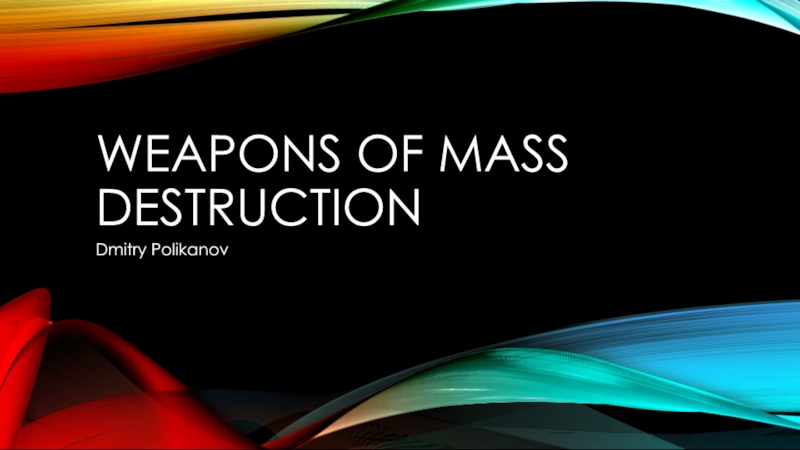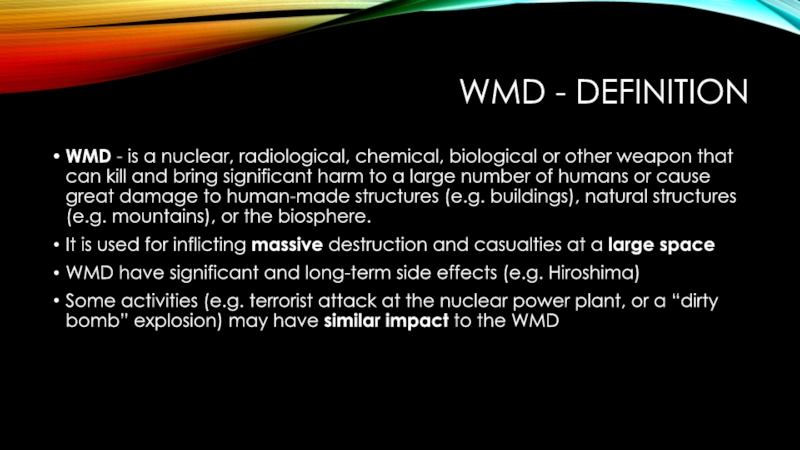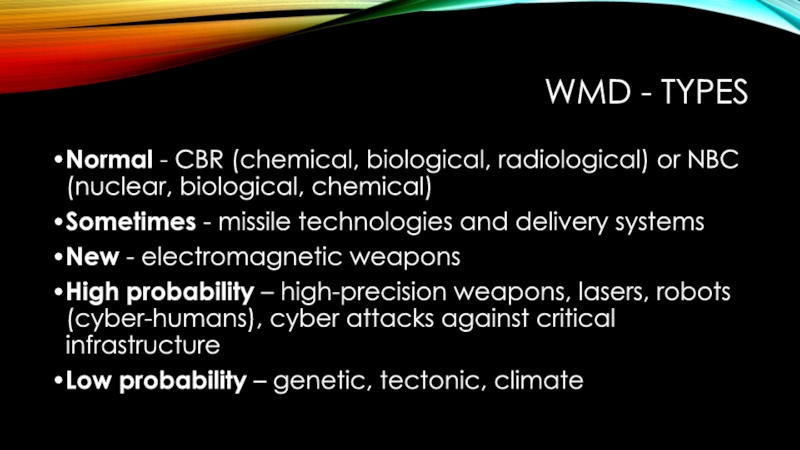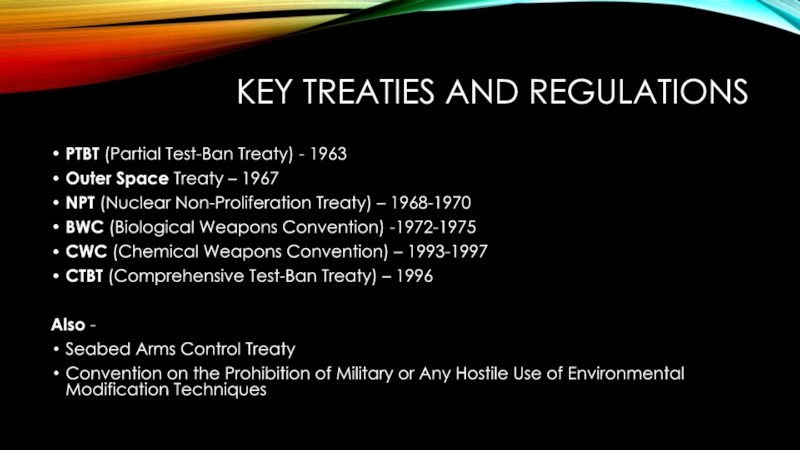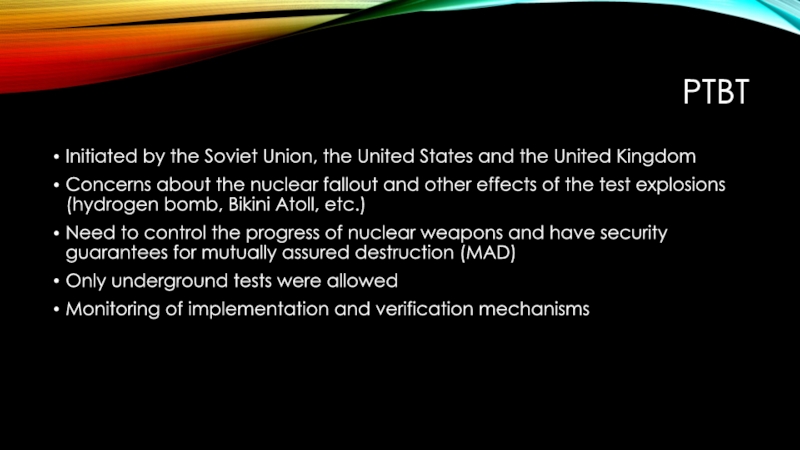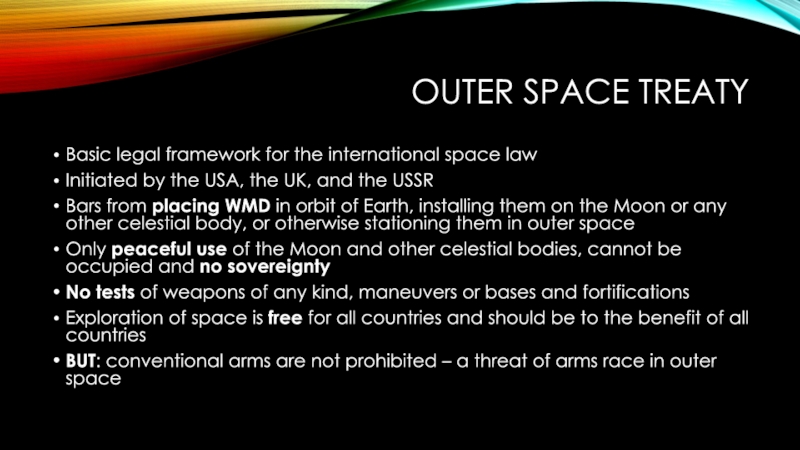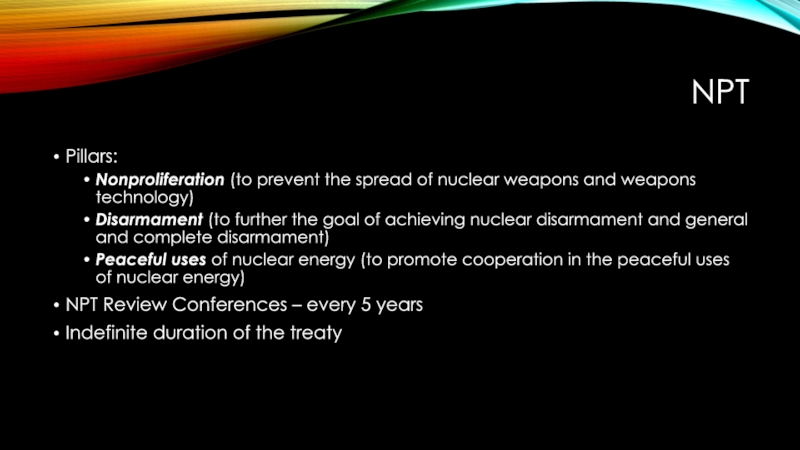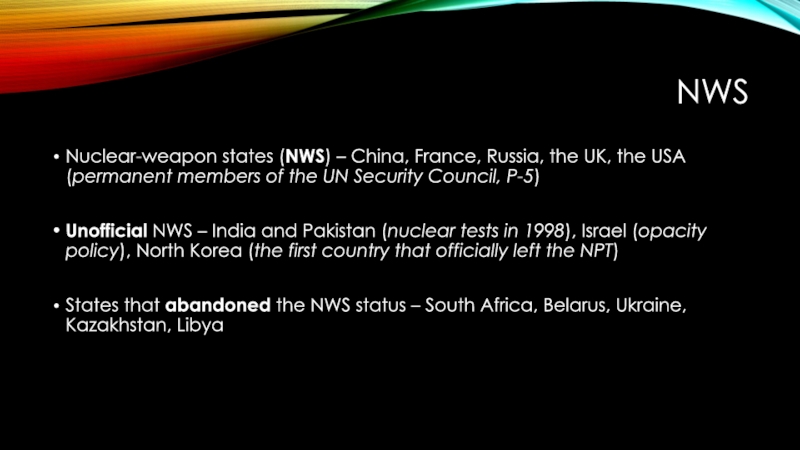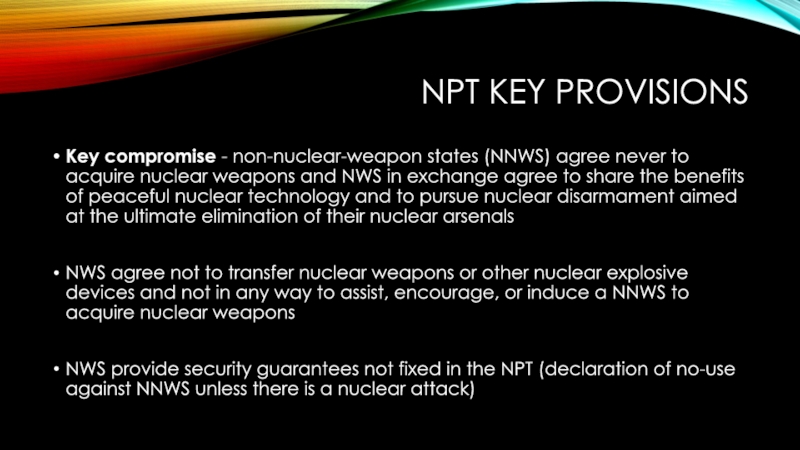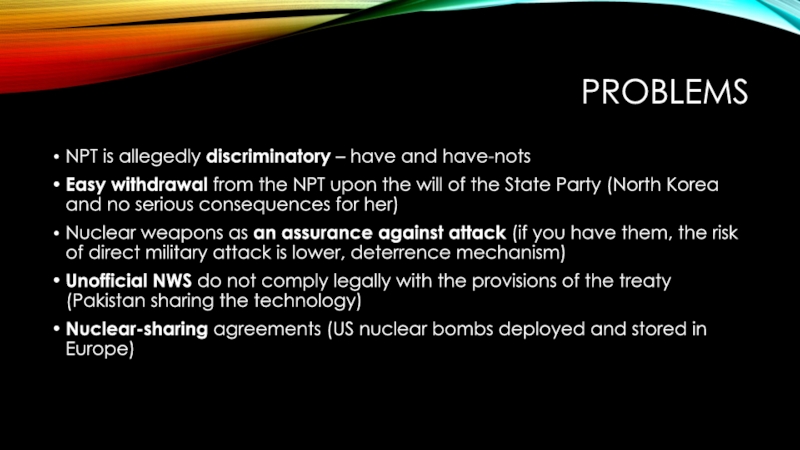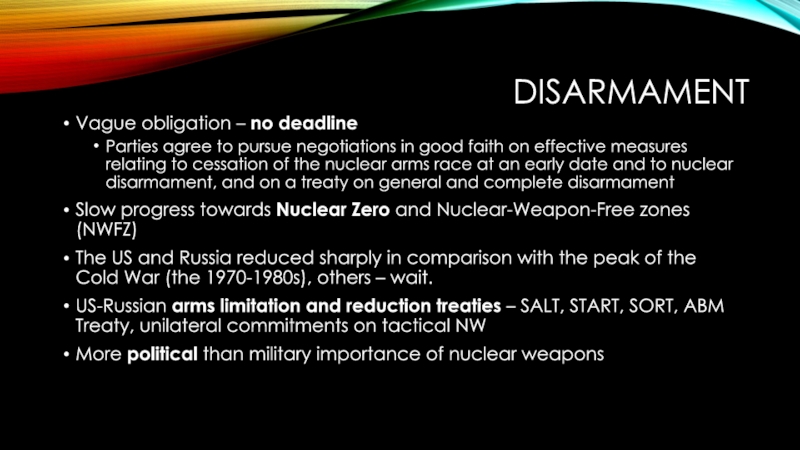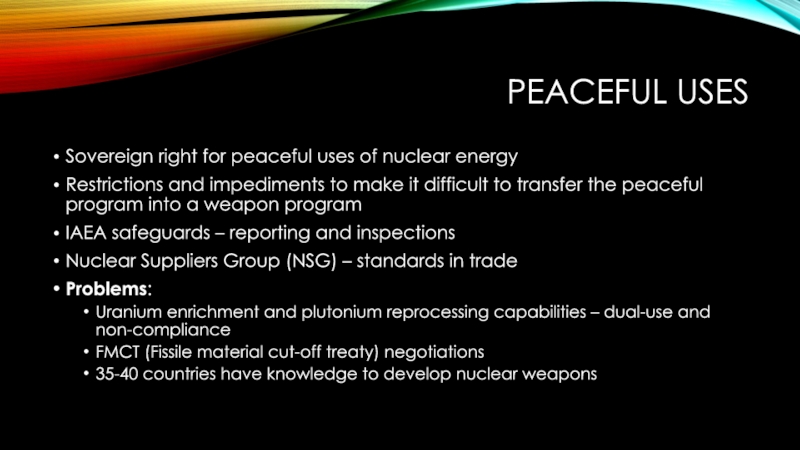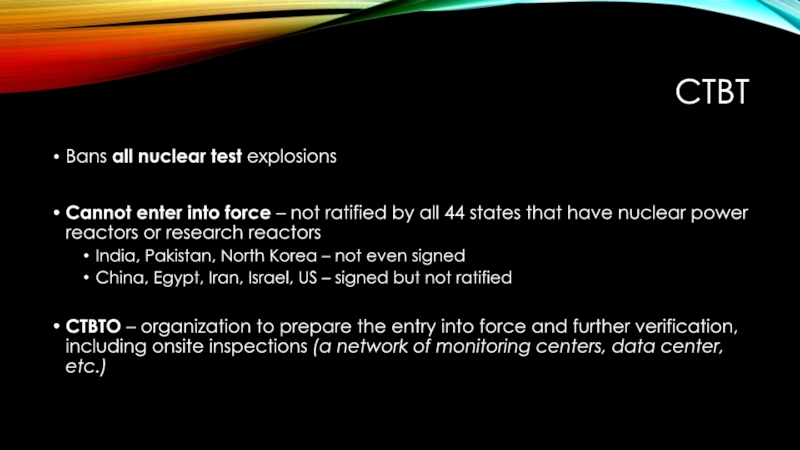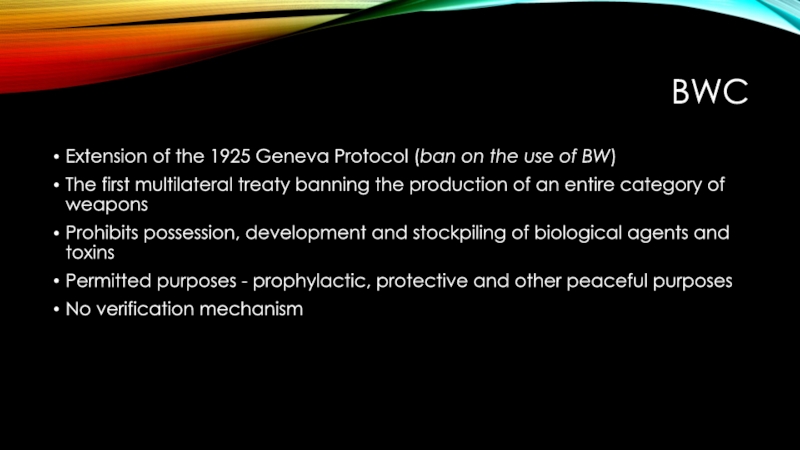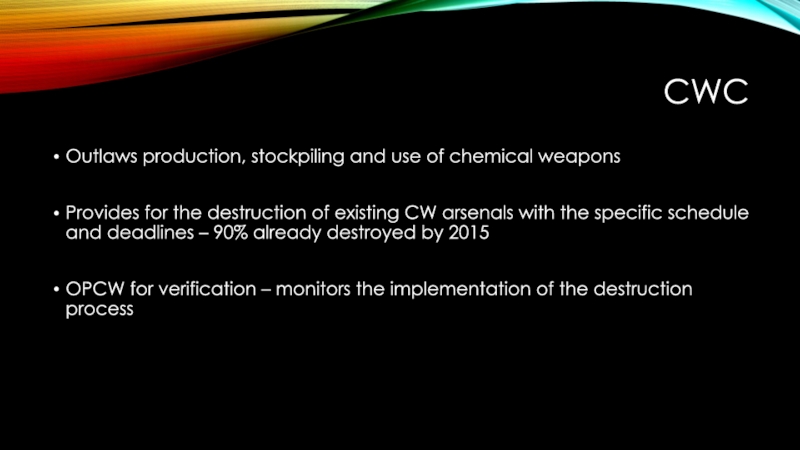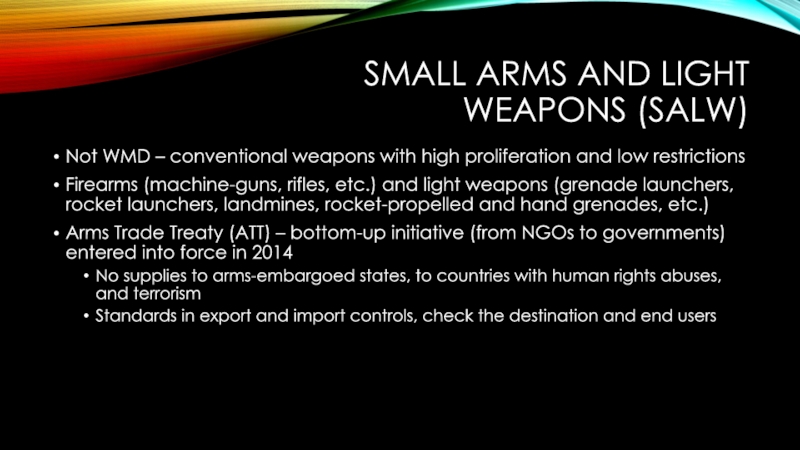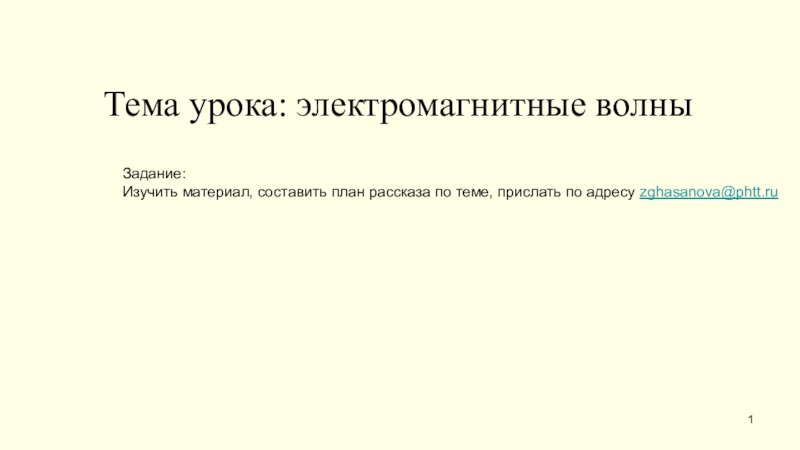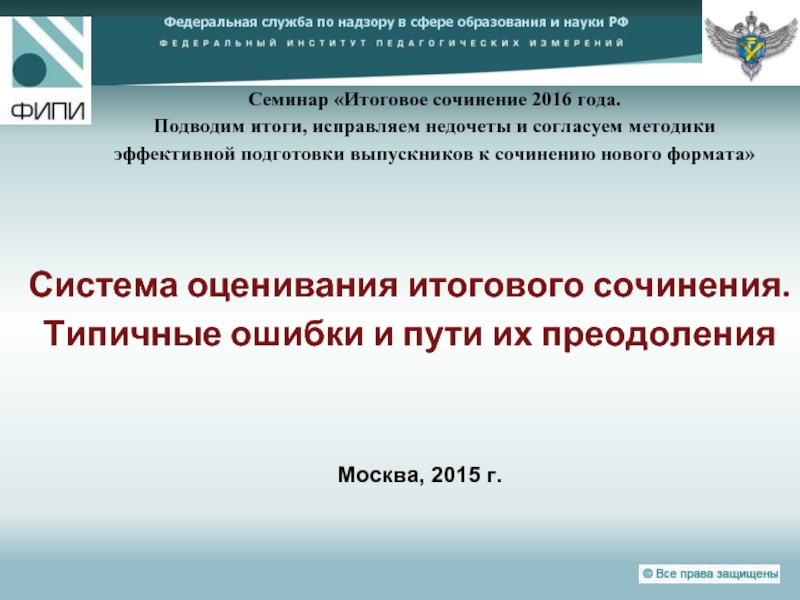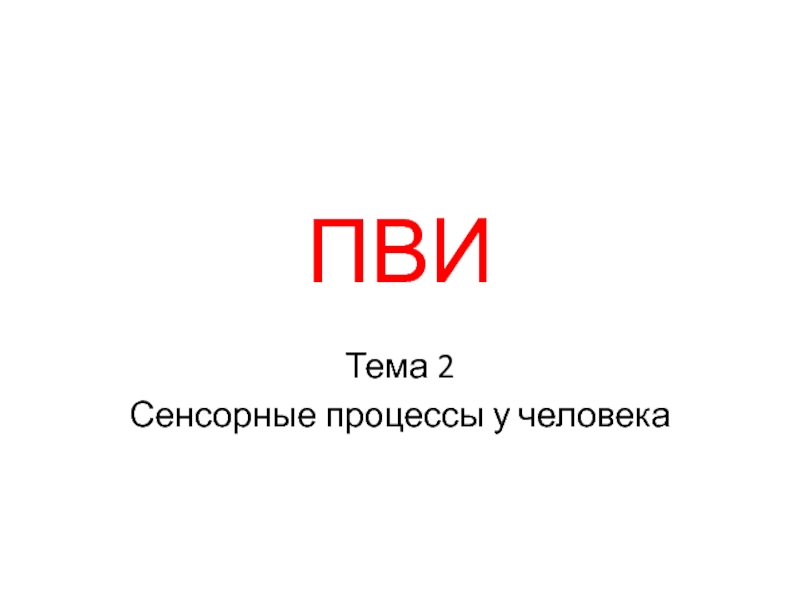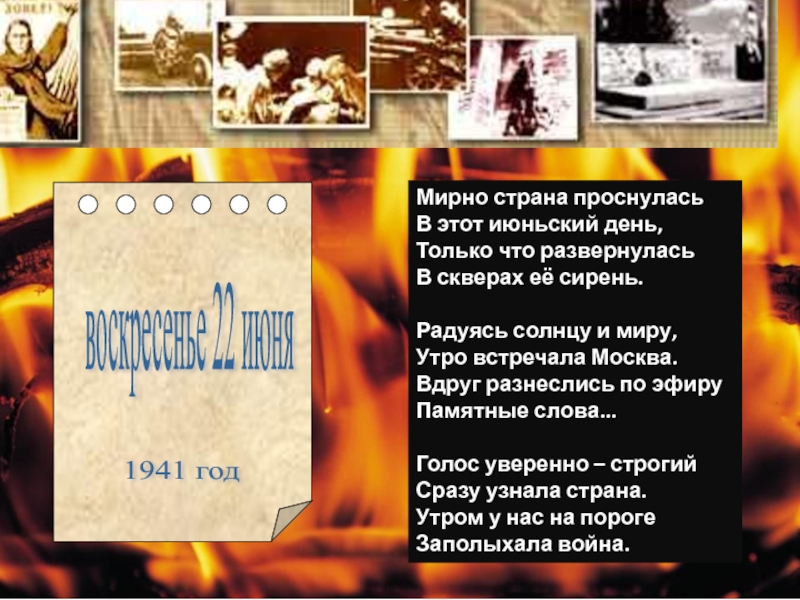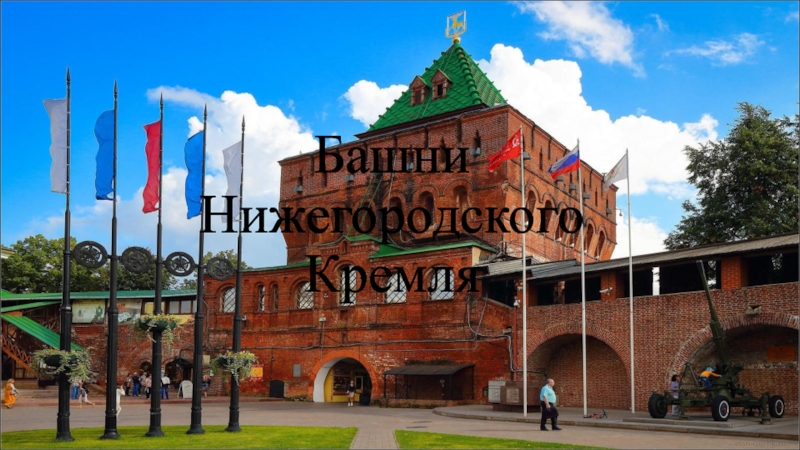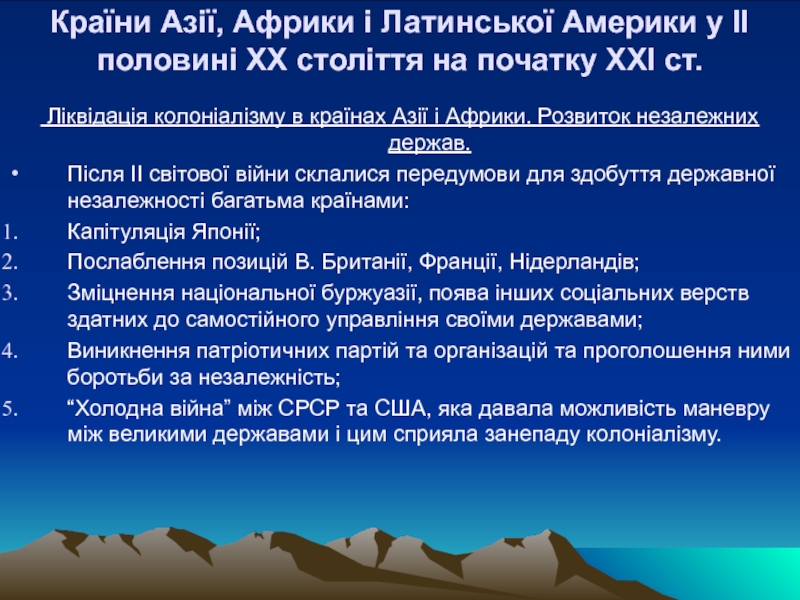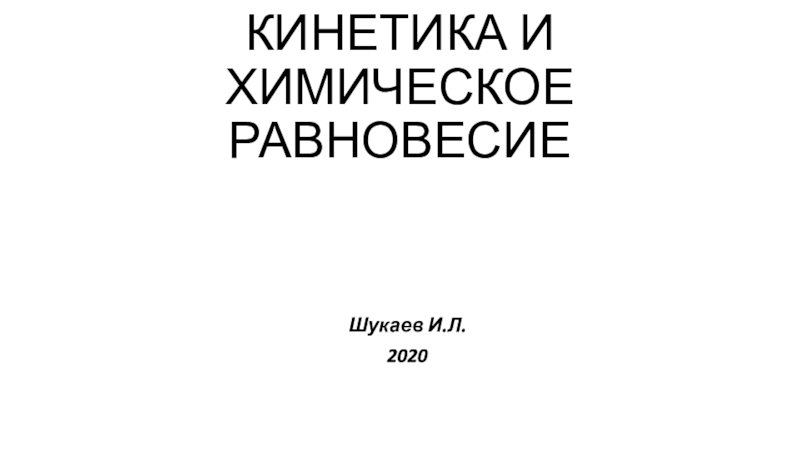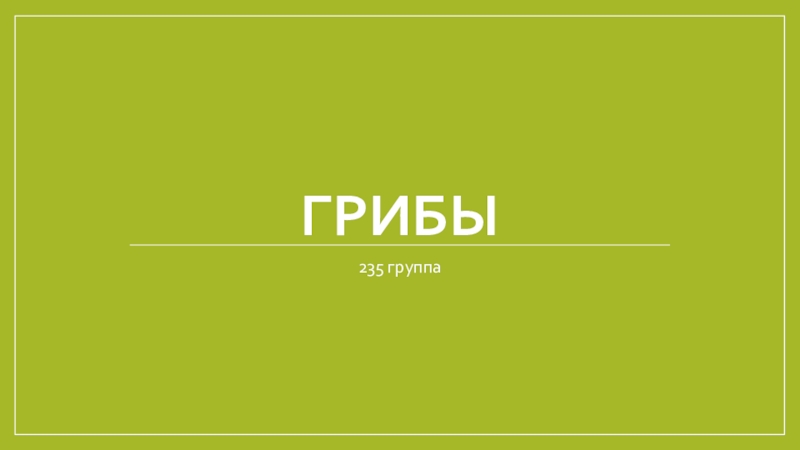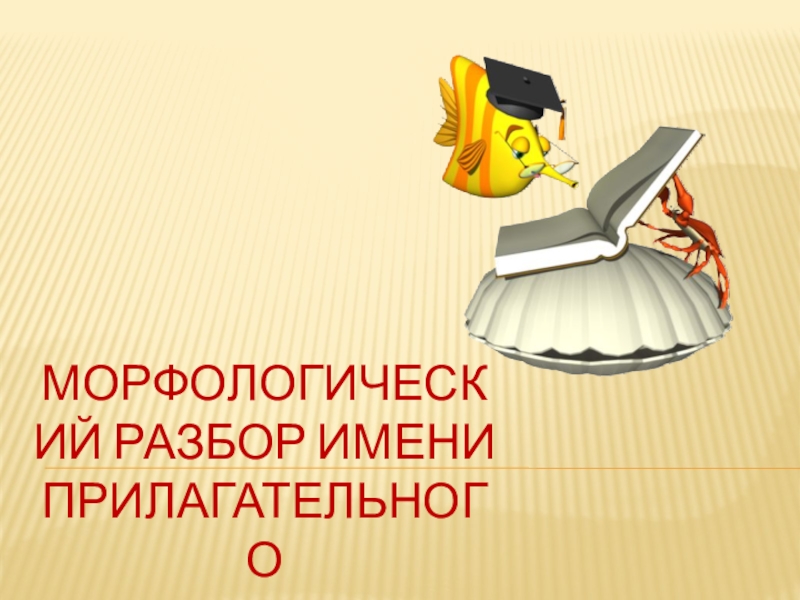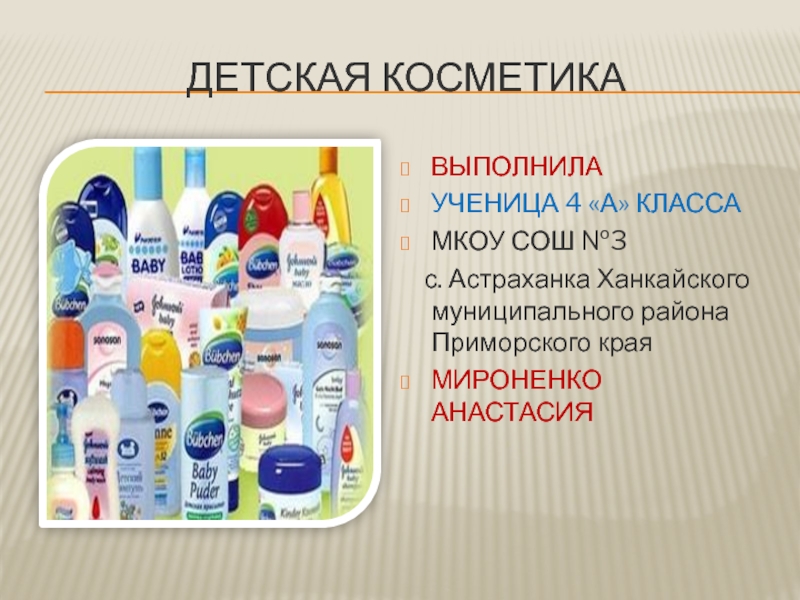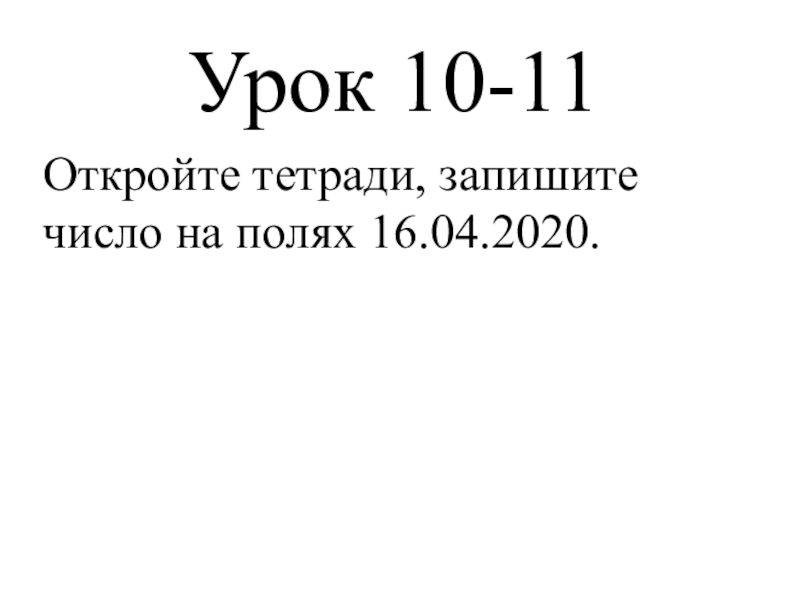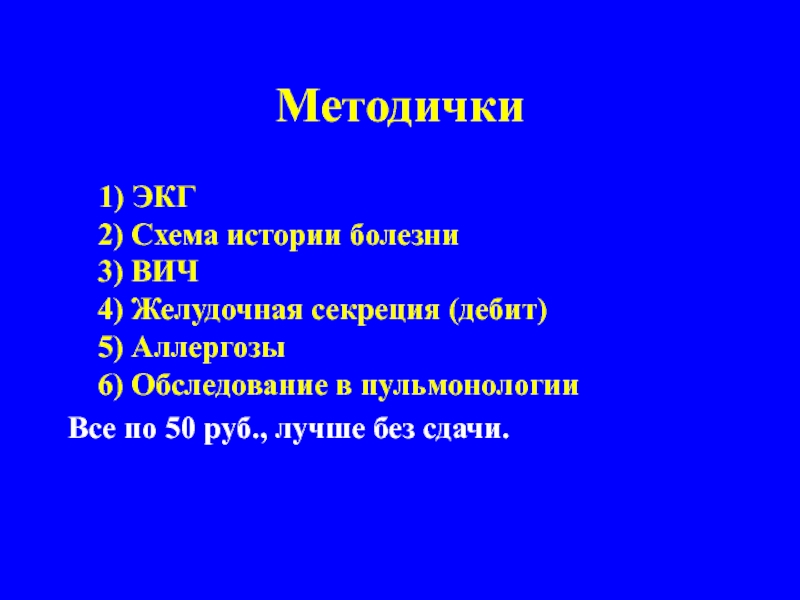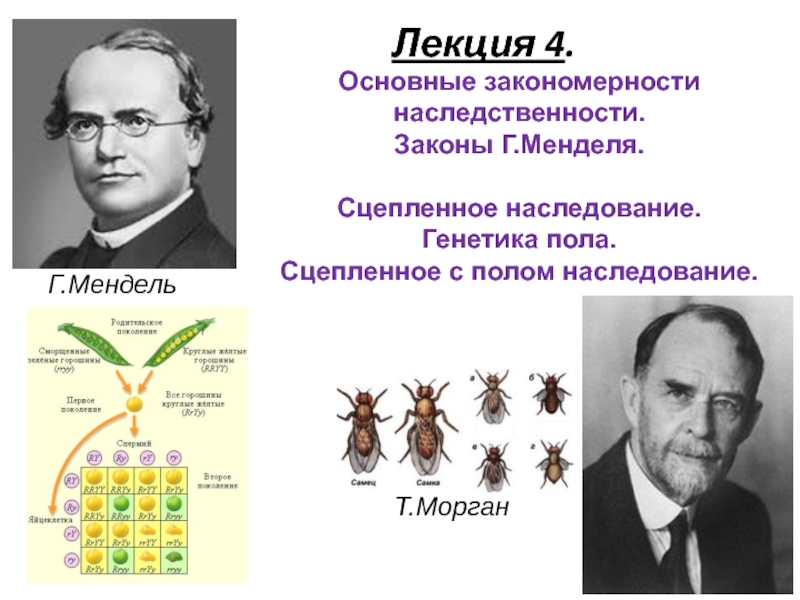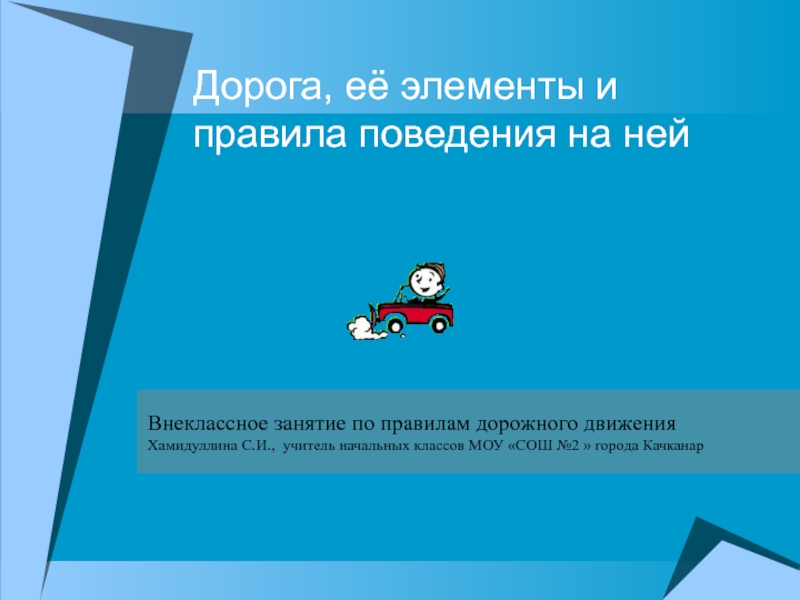Слайд 1Weapons of mass destruction
Dmitry Polikanov
Слайд 2WMD - definition
WMD - is a nuclear, radiological, chemical, biological
or other weapon that can kill and bring significant harm
to a large number of humans or cause great damage to human-made structures (e.g. buildings), natural structures (e.g. mountains), or the biosphere.
It is used for inflicting massive destruction and casualties at a large space
WMD have significant and long-term side effects (e.g. Hiroshima)
Some activities (e.g. terrorist attack at the nuclear power plant, or a “dirty bomb” explosion) may have similar impact to the WMD
Слайд 3WMD - types
Normal - CBR (chemical, biological, radiological) or NBC
(nuclear, biological, chemical)
Sometimes - missile technologies and delivery systems
New -
electromagnetic weapons
High probability – high-precision weapons, lasers, robots (cyber-humans), cyber attacks against critical infrastructure
Low probability – genetic, tectonic, climate
Слайд 4Key treaties and regulations
PTBT (Partial Test-Ban Treaty) - 1963
Outer Space
Treaty – 1967
NPT (Nuclear Non-Proliferation Treaty) – 1968-1970
BWC (Biological Weapons
Convention) -1972-1975
CWC (Chemical Weapons Convention) – 1993-1997
CTBT (Comprehensive Test-Ban Treaty) – 1996
Also -
Seabed Arms Control Treaty
Convention on the Prohibition of Military or Any Hostile Use of Environmental Modification Techniques
Слайд 5PTBT
Initiated by the Soviet Union, the United States and the
United Kingdom
Concerns about the nuclear fallout and other effects of
the test explosions (hydrogen bomb, Bikini Atoll, etc.)
Need to control the progress of nuclear weapons and have security guarantees for mutually assured destruction (MAD)
Only underground tests were allowed
Monitoring of implementation and verification mechanisms
Слайд 6Outer Space Treaty
Basic legal framework for the international space law
Initiated
by the USA, the UK, and the USSR
Bars from placing
WMD in orbit of Earth, installing them on the Moon or any other celestial body, or otherwise stationing them in outer space
Only peaceful use of the Moon and other celestial bodies, cannot be occupied and no sovereignty
No tests of weapons of any kind, maneuvers or bases and fortifications
Exploration of space is free for all countries and should be to the benefit of all countries
BUT: conventional arms are not prohibited – a threat of arms race in outer space
Слайд 7NPT
Pillars:
Nonproliferation (to prevent the spread of nuclear weapons and weapons
technology)
Disarmament (to further the goal of achieving nuclear disarmament and
general and complete disarmament)
Peaceful uses of nuclear energy (to promote cooperation in the peaceful uses of nuclear energy)
NPT Review Conferences – every 5 years
Indefinite duration of the treaty
Слайд 8NWS
Nuclear-weapon states (NWS) – China, France, Russia, the UK,
the USA (permanent members of the UN Security Council, P-5)
Unofficial
NWS – India and Pakistan (nuclear tests in 1998), Israel (opacity policy), North Korea (the first country that officially left the NPT)
States that abandoned the NWS status – South Africa, Belarus, Ukraine, Kazakhstan, Libya
Слайд 9NPT key provisions
Key compromise - non-nuclear-weapon states (NNWS) agree never
to acquire nuclear weapons and NWS in exchange agree to
share the benefits of peaceful nuclear technology and to pursue nuclear disarmament aimed at the ultimate elimination of their nuclear arsenals
NWS agree not to transfer nuclear weapons or other nuclear explosive devices and not in any way to assist, encourage, or induce a NNWS to acquire nuclear weapons
NWS provide security guarantees not fixed in the NPT (declaration of no-use against NNWS unless there is a nuclear attack)
Слайд 10Problems
NPT is allegedly discriminatory – have and have-nots
Easy withdrawal from
the NPT upon the will of the State Party (North
Korea and no serious consequences for her)
Nuclear weapons as an assurance against attack (if you have them, the risk of direct military attack is lower, deterrence mechanism)
Unofficial NWS do not comply legally with the provisions of the treaty (Pakistan sharing the technology)
Nuclear-sharing agreements (US nuclear bombs deployed and stored in Europe)
Слайд 11Disarmament
Vague obligation – no deadline
Parties agree to pursue negotiations in
good faith on effective measures relating to cessation of the
nuclear arms race at an early date and to nuclear disarmament, and on a treaty on general and complete disarmament
Slow progress towards Nuclear Zero and Nuclear-Weapon-Free zones (NWFZ)
The US and Russia reduced sharply in comparison with the peak of the Cold War (the 1970-1980s), others – wait.
US-Russian arms limitation and reduction treaties – SALT, START, SORT, ABM Treaty, unilateral commitments on tactical NW
More political than military importance of nuclear weapons
Слайд 12Peaceful uses
Sovereign right for peaceful uses of nuclear energy
Restrictions and
impediments to make it difficult to transfer the peaceful program
into a weapon program
IAEA safeguards – reporting and inspections
Nuclear Suppliers Group (NSG) – standards in trade
Problems:
Uranium enrichment and plutonium reprocessing capabilities – dual-use and non-compliance
FMCT (Fissile material cut-off treaty) negotiations
35-40 countries have knowledge to develop nuclear weapons
Слайд 13CTBT
Bans all nuclear test explosions
Cannot enter into force – not
ratified by all 44 states that have nuclear power reactors
or research reactors
India, Pakistan, North Korea – not even signed
China, Egypt, Iran, Israel, US – signed but not ratified
CTBTO – organization to prepare the entry into force and further verification, including onsite inspections (a network of monitoring centers, data center, etc.)
Слайд 14BWC
Extension of the 1925 Geneva Protocol (ban on the use
of BW)
The first multilateral treaty banning the production of an
entire category of weapons
Prohibits possession, development and stockpiling of biological agents and toxins
Permitted purposes - prophylactic, protective and other peaceful purposes
No verification mechanism
Слайд 15CWC
Outlaws production, stockpiling and use of chemical weapons
Provides for the
destruction of existing CW arsenals with the specific schedule and
deadlines – 90% already destroyed by 2015
OPCW for verification – monitors the implementation of the destruction process
Слайд 16Small arms and light weapons (SALW)
Not WMD – conventional weapons
with high proliferation and low restrictions
Firearms (machine-guns, rifles, etc.) and
light weapons (grenade launchers, rocket launchers, landmines, rocket-propelled and hand grenades, etc.)
Arms Trade Treaty (ATT) – bottom-up initiative (from NGOs to governments) entered into force in 2014
No supplies to arms-embargoed states, to countries with human rights abuses, and terrorism
Standards in export and import controls, check the destination and end users
